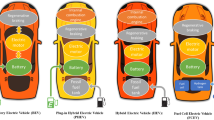Abstract
To improve the riding comfort and rational utilization of the electrical energy captured by an automotive thermoelectric generator (ATEG), a temperature-controlled car seat was constructed to adjust the temperature of the car seat surface. Powered by the ATEG and the battery, the seat-embedded air conditioner can improve the riding comfort using a thermoelectric device to adjust the surface temperature of the seat, with an air duct to regulate the cold side and hot side of the thermoelectric device. The performance of the thermoelectric cooler (TEC) and theoretical analysis on the optimum state of the TEC device are put forward. To verify the rationality of the air duct design and to ensure sufficient air supply, the velocity field of the air duct system was obtained by means of the finite element method. To validate the reliability of the numerical simulation, the air velocity around the thermoelectric device was measured by a wind speed transmitter. The performance of the temperature-controlled car seat has been validated and is in good agreement with bench tests and real vehicle tests.
Similar content being viewed by others
References
X. Liu and Y.D. Deng, Appl. Therm. Eng. 71, 364 (2014).
F.K. Meng, L.G. Chen, and S.R. Sui, Math. Comput. Model. 52, 586 (2010).
W.H. Chen, C.C. Wang, and C.I. Hung, Energy Convers. Manag. 87, 566 (2014).
X. Liu, Y.D. Deng, W.S. Wang, and C.Q. Su, J. Electron. Mater. 44, 2203 (2014).
M. Ferreira and A. Tribess, SAE Technical Paper, 2009-36-0043 (2009).
J. Lustbader, SAE Technical Paper, 2005-01-2056 (2005).
H.S. Choi, S. Yun, and K.I. Whang, Appl. Therm. Eng. 27, 2841 (2007).
M. Vinoth and D. Prema, 2014 International Conference on Computation of Power, Energy, Information and Communication (ICCPEIC), 488 (2014).
D. Mihai, 2012 International Conference on Applied and Theoretical Electricity (ICATE), 1 (2012).
M. Menon and H.H. Asada, 2006 American Control Conference, (2006).
J.W. Finn and J.R. Wagner, IEEE Trans. Veh. Technol. 61, 1999 (2012).
Á.G. Miranda, T.S. Chen, and C.W. Hong, Renew. Sustain. Energy Rev. 38, 903 (2014).
P.M. Rutkowski, SAE Int. J. Passeng. Cars Mech. Syst. 3, 523 (2010).
Acknowledgement
The research was supported by National Natural Science Foundation of China (Grant No. 51305312), National Basic Research Program of China (973 Program, Grant No. 2013CB632505) and Fundamental Research Funds for the Central Universities (Grant No. WUT142207005).
Author information
Authors and Affiliations
Corresponding author
Rights and permissions
About this article
Cite this article
Du, H., Wang, Y.P., Yuan, X.H. et al. Experimental Investigation of a Temperature-Controlled Car Seat Powered by an Exhaust Thermoelectric Generator. J. Electron. Mater. 45, 1529–1539 (2016). https://doi.org/10.1007/s11664-015-4095-8
Received:
Accepted:
Published:
Issue Date:
DOI: https://doi.org/10.1007/s11664-015-4095-8




